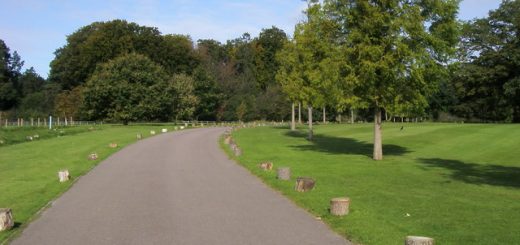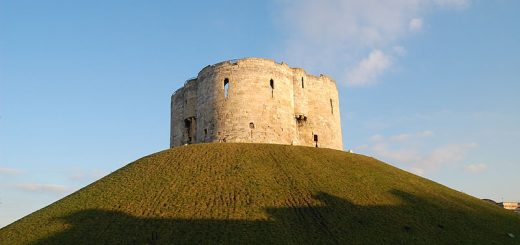Melrose Abbey
In 1136 the Cistercian Melrose Abbey was founded following a request from King David I (Scotland) (Born 1084 – Died 24 May 1153) and took ten years to build, though it was added to and extended over the following decades. Being in the border region the Abbey was unfortunately damaged several times during conflicts between the English and the Scottish.
 In 1322 it was badly damaged when the army of King Edward II (Born 25 April 1284 – Died 21 September 1327), attacked the town of Melrose and again in 1385 when it was burned down on by the forces of King Richard II (Born 6 January 1367 – Died14 February 1400). King Henry VIII’s “Rough Wooing” of Scotland caused further damage when he attempted to use a military campaign against Scotland to force a marriage between the future Mary Queen of Scots (Born 8 December 1542 – Died 8 February 1587) and his son Prince Edward (King Edward VI) (Born 12 October 1537 – Died 6 July 1553). Melrose Abbey never recovered from this period of aggression, it was never fully repaired and its fortunes declined. Its last monk died in 1590.
In 1322 it was badly damaged when the army of King Edward II (Born 25 April 1284 – Died 21 September 1327), attacked the town of Melrose and again in 1385 when it was burned down on by the forces of King Richard II (Born 6 January 1367 – Died14 February 1400). King Henry VIII’s “Rough Wooing” of Scotland caused further damage when he attempted to use a military campaign against Scotland to force a marriage between the future Mary Queen of Scots (Born 8 December 1542 – Died 8 February 1587) and his son Prince Edward (King Edward VI) (Born 12 October 1537 – Died 6 July 1553). Melrose Abbey never recovered from this period of aggression, it was never fully repaired and its fortunes declined. Its last monk died in 1590.
Michael Scot (Born 1175 – Died circa1232)
Melrose Abbey has been suggested as one of the potential final resting places of the ‘Scottish Wizard’, Michael Scot who wrote about the occult, astrology and alchemy. Many legends have grown around Michael Scot and he is associated with stories attached to many locations, including Eildon Hill and Long Meg and Her Daughters. Some say he lived for a while at Glenluce, another Cistercian Abbey and it may be this or more likely the 1805 poem ‘The Lay of the Minstrel’ by Walter Scott that has linked him with so closely with Melrose. In 1812 a stone coffin was discovered in an aisle which has been associated with Michael Scot, and even though it is not proven to be his tomb, it has been speculated that he therefore haunts Melrose.
Vampire
Whether Michael Scot and his magical text books are buried in Melrose or not, there is a twelfth century story concerning a haunting, or vampire, associated with a burial at the Abbey. The following account is by Augustinian Canon William Parvus, also known as William of Newburgh (or Newbury) (Born 1136 – Died 1198).
 A few years ago the chaplain of a certain illustrious lady, casting off mortality, was consigned to the tomb in that noble monastery which is called Melrose. This man, having little respect for the sacred order to which he belonged, was excessively secular in his pursuits, and – what especially blackens his reputation as a minister of the holy sacrament – so addicted to the vanity of the chase as to be designated by many by the infamous title of Hundeprest, or the dog-priest; and this occupation, during his lifetime, was either laughed at by men, or considered in a worldly view; but after his death – as the event showed – the guiltiness of it was brought to light: for, issuing from the grave at night-time, he was prevented by the meritorious resistance of its holy inmates from injuring or terrifying any one within the monastery itself; whereupon he wandered beyond the walls, and hovered chiefly, with loud groans and horrible murmurs, round the bedchamber of his former mistress. She, after this had frequently occurred, becoming exceedingly terrified, revealed her fears or danger to one of the friars who visited her about the business of the monastery; demanding with tears that prayers more earnest than usual should be poured out to the Lord in her behalf as for one in agony. With whose anxiety the friar – for she appeared deserving of the best endeavors, on the part of the holy convent of that place, by her frequent donations to it – piously and justly sympathized, and promised a speedy remedy through the mercy of the Most High Provider for all.
A few years ago the chaplain of a certain illustrious lady, casting off mortality, was consigned to the tomb in that noble monastery which is called Melrose. This man, having little respect for the sacred order to which he belonged, was excessively secular in his pursuits, and – what especially blackens his reputation as a minister of the holy sacrament – so addicted to the vanity of the chase as to be designated by many by the infamous title of Hundeprest, or the dog-priest; and this occupation, during his lifetime, was either laughed at by men, or considered in a worldly view; but after his death – as the event showed – the guiltiness of it was brought to light: for, issuing from the grave at night-time, he was prevented by the meritorious resistance of its holy inmates from injuring or terrifying any one within the monastery itself; whereupon he wandered beyond the walls, and hovered chiefly, with loud groans and horrible murmurs, round the bedchamber of his former mistress. She, after this had frequently occurred, becoming exceedingly terrified, revealed her fears or danger to one of the friars who visited her about the business of the monastery; demanding with tears that prayers more earnest than usual should be poured out to the Lord in her behalf as for one in agony. With whose anxiety the friar – for she appeared deserving of the best endeavors, on the part of the holy convent of that place, by her frequent donations to it – piously and justly sympathized, and promised a speedy remedy through the mercy of the Most High Provider for all.
 Thereupon, returning to the monastery, he obtained the companionship of another friar, of equally determined spirit, and two powerful young men, with whom he intended with constant vigilance to keep guard over the cemetery where that miserable priest lay buried. These four, therefore, furnished with arms and animated with courage, passed the night in that place, safe in the assistance which each afforded to the other. Midnight had now passed by, and no monster appeared; upon which it came to pass that three of the party, leaving him only who had sought their company on the spot, departed into the nearest house, for the purpose, as they averred, of warming themselves, for the night was cold. As soon as this man was left alone in this place, the devil, imagining that he had found the right moment for breaking his courage, incontinently roused up his own chosen vessel, who appeared to have reposed longer than usual. Having beheld this from afar, he grew stiff with terror by reason of his being alone; but soon recovering his courage, and no place of refuge being at hand, he valiantly withstood the onset of the fiend, who came rushing upon him with a terrible noise, and he struck the axe which he wielded in his hand deep into his body. On receiving this wound, the monster groaned aloud, and turning his back, fled with a rapidity not at all interior to that with which he had advanced, while the admirable man urged his flying foe from behind, and compelled him to seek his own tomb again; which opening of its own accord, and receiving its guest from the advance of the pursuer, immediately appeared to close again with the same facility. In the meantime, they who, impatient of the coldness of the night, had retreated to the fire ran up, though somewhat too late, and, having heard what had happened, rendered needful assistance in digging up and removing from the midst of the tomb the accursed corpse at the earliest dawn. When they had divested it of the clay cast forth with it, they found the huge wound it had received, and a great quantity of gore which had flowed from it in the sepulchre; and so having carried it away beyond the walls of the monastery and burnt it, they scattered the ashes to the winds. These things I have explained in a simple narration, as I myself heard them recounted by religious men.
Thereupon, returning to the monastery, he obtained the companionship of another friar, of equally determined spirit, and two powerful young men, with whom he intended with constant vigilance to keep guard over the cemetery where that miserable priest lay buried. These four, therefore, furnished with arms and animated with courage, passed the night in that place, safe in the assistance which each afforded to the other. Midnight had now passed by, and no monster appeared; upon which it came to pass that three of the party, leaving him only who had sought their company on the spot, departed into the nearest house, for the purpose, as they averred, of warming themselves, for the night was cold. As soon as this man was left alone in this place, the devil, imagining that he had found the right moment for breaking his courage, incontinently roused up his own chosen vessel, who appeared to have reposed longer than usual. Having beheld this from afar, he grew stiff with terror by reason of his being alone; but soon recovering his courage, and no place of refuge being at hand, he valiantly withstood the onset of the fiend, who came rushing upon him with a terrible noise, and he struck the axe which he wielded in his hand deep into his body. On receiving this wound, the monster groaned aloud, and turning his back, fled with a rapidity not at all interior to that with which he had advanced, while the admirable man urged his flying foe from behind, and compelled him to seek his own tomb again; which opening of its own accord, and receiving its guest from the advance of the pursuer, immediately appeared to close again with the same facility. In the meantime, they who, impatient of the coldness of the night, had retreated to the fire ran up, though somewhat too late, and, having heard what had happened, rendered needful assistance in digging up and removing from the midst of the tomb the accursed corpse at the earliest dawn. When they had divested it of the clay cast forth with it, they found the huge wound it had received, and a great quantity of gore which had flowed from it in the sepulchre; and so having carried it away beyond the walls of the monastery and burnt it, they scattered the ashes to the winds. These things I have explained in a simple narration, as I myself heard them recounted by religious men.
Note: The embalmed heart of King Robert I (Scotland) (also known as Robert the Bruce) (Born 11 July 1274 – Died 7 June 1329) is buried at Melrose Abbey as is King Alexander II (Scotland) (Born 24 August 1198 – Died 6 July 1249).




Recent Comments